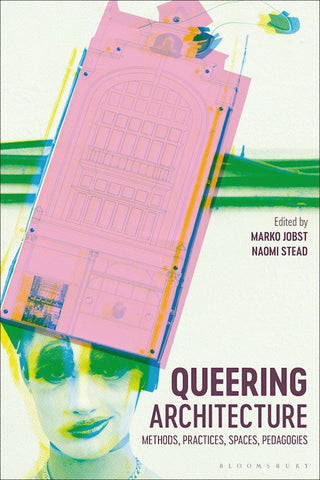Queering Architecture : Methods, Practices, Spaces, Pedagogies
- Unit price
- / per
-
Author:JOBST Marko / STEAD Naomi
-
ISBN:9781350267084
-
Publication Date:June 2024
-
Edition:1
-
Pages:296
-
Binding:Paperback
-
Publisher:Bloomsbury
-
Country of Publication:United Kingdom


A Back Order button means that we don’t have the book in stock at our store. It may already be on order – or we can order it for you from a publisher or distributor at no additional cost.
As we source items from around the globe, a back-order can take anywhere from 5 days to several weeks to arrive, depending on the title.
To check how long this might take, you’re welcome to contact us and we can provide an ETA or any other information you need. We recommend checking the timeframe before committing to an online order.
Queering Architecture : Methods, Practices, Spaces, Pedagogies
- Unit price
- / per
-
Author:JOBST Marko / STEAD Naomi
-
ISBN:9781350267084
-
Publication Date:June 2024
-
Edition:1
-
Pages:296
-
Binding:Paperback
-
Publisher:Bloomsbury
-
Country of Publication:United Kingdom
Description
Queering Architecture explores what it means to “queer” architecture, challenging the methods and methodologies of architectural discourse and subverting disciplinary power structures.
Architecture as a discipline, a profession and an applied practice, is always subordinate to its own conceptual framework of orderliness. How, then, can we look at queering architectural discourse when the very term 'queer' – celebrated for its elusive, slippery nature – resists and attacks such order?
The essays in this book explore this paradox from a diverse range of perspectives – from the questions of mapping queer theory in architecture; to the issues of queer architectural archives, or lack thereof; to the non-Western linguistic challenges to the very term queer alongside decolonial approaches to architecture via indigeneity and landscape.
Queering Architecture not only provides a bold challenge to the normative methods employed in architectural discourse but addresses the paradoxical nature of establishing 'queer' methodologies in itself. Offering guerrilla tactics and interventions for the discipline alongside a developing theoretical framework, it is essential reading for architects, designers, queer and LGBTQ+ theorists alike.
Adding product to your cart
You may also like
A Back Order button means that we don’t have the book in stock at our store. It may already be on order – or we can order it for you from a publisher or distributor at no additional cost.
As we source items from around the globe, a back-order can take anywhere from 5 days to several weeks to arrive, depending on the title.
To check how long this might take, you’re welcome to contact us and we can provide an ETA or any other information you need. We recommend checking the timeframe before committing to an online order.
You may also like
You may also like
-
Queering Architecture explores what it means to “queer” architecture, challenging the methods and methodologies of architectural discourse and subverting disciplinary power structures.
Architecture as a discipline, a profession and an applied practice, is always subordinate to its own conceptual framework of orderliness. How, then, can we look at queering architectural discourse when the very term 'queer' – celebrated for its elusive, slippery nature – resists and attacks such order?
The essays in this book explore this paradox from a diverse range of perspectives – from the questions of mapping queer theory in architecture; to the issues of queer architectural archives, or lack thereof; to the non-Western linguistic challenges to the very term queer alongside decolonial approaches to architecture via indigeneity and landscape.
Queering Architecture not only provides a bold challenge to the normative methods employed in architectural discourse but addresses the paradoxical nature of establishing 'queer' methodologies in itself. Offering guerrilla tactics and interventions for the discipline alongside a developing theoretical framework, it is essential reading for architects, designers, queer and LGBTQ+ theorists alike.
-
-
Author: JOBST Marko / STEAD NaomiISBN: 9781350267084Publication Date: June 2024Edition: 1Pages: 296Binding: PaperbackPublisher: BloomsburyCountry of Publication: United Kingdom
Queering Architecture explores what it means to “queer” architecture, challenging the methods and methodologies of architectural discourse and subverting disciplinary power structures.
Architecture as a discipline, a profession and an applied practice, is always subordinate to its own conceptual framework of orderliness. How, then, can we look at queering architectural discourse when the very term 'queer' – celebrated for its elusive, slippery nature – resists and attacks such order?
The essays in this book explore this paradox from a diverse range of perspectives – from the questions of mapping queer theory in architecture; to the issues of queer architectural archives, or lack thereof; to the non-Western linguistic challenges to the very term queer alongside decolonial approaches to architecture via indigeneity and landscape.
Queering Architecture not only provides a bold challenge to the normative methods employed in architectural discourse but addresses the paradoxical nature of establishing 'queer' methodologies in itself. Offering guerrilla tactics and interventions for the discipline alongside a developing theoretical framework, it is essential reading for architects, designers, queer and LGBTQ+ theorists alike.
-
Author: JOBST Marko / STEAD NaomiISBN: 9781350267084Publication Date: June 2024Edition: 1Pages: 296Binding: PaperbackPublisher: BloomsburyCountry of Publication: United Kingdom
-



